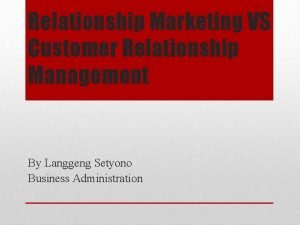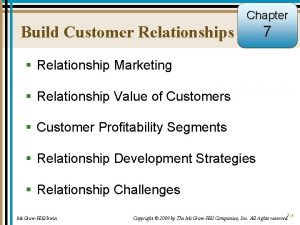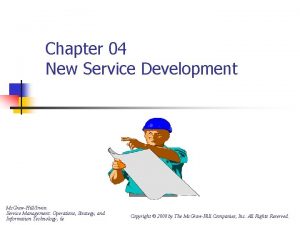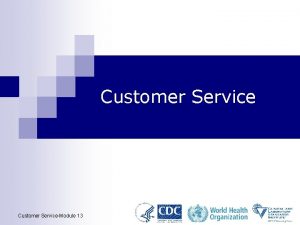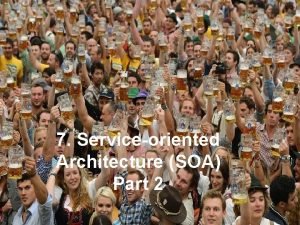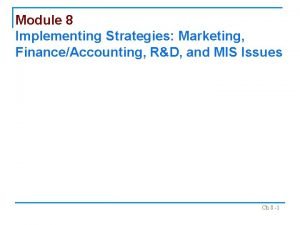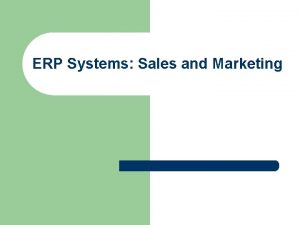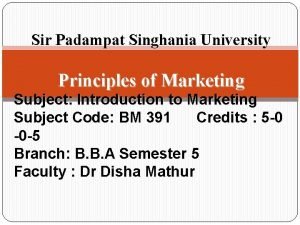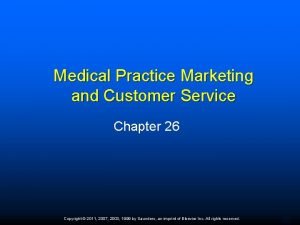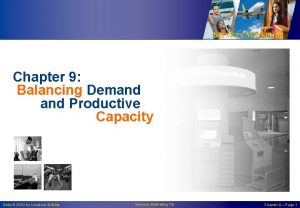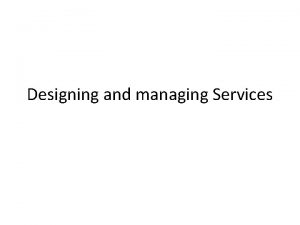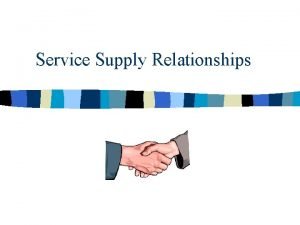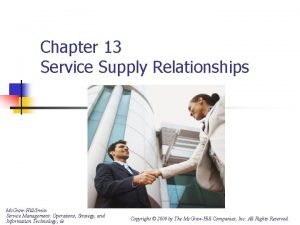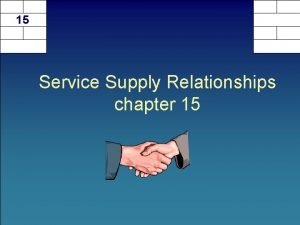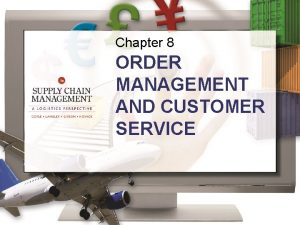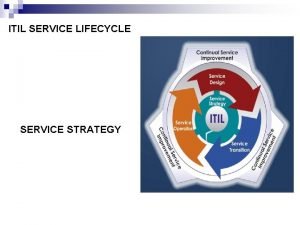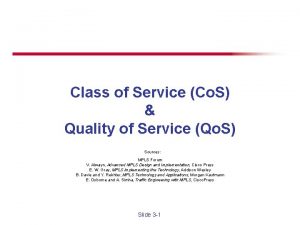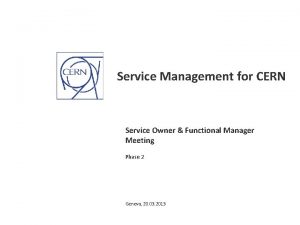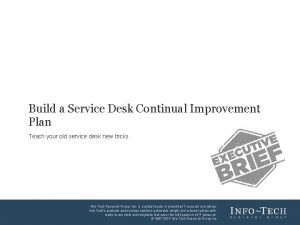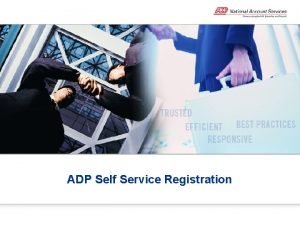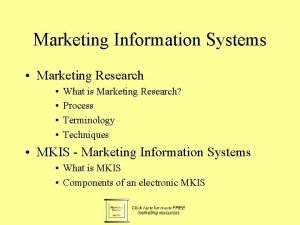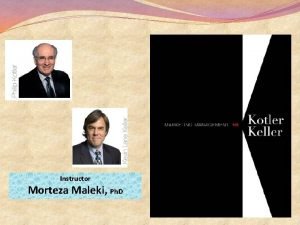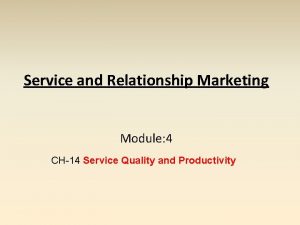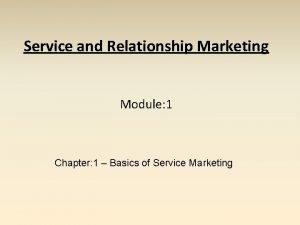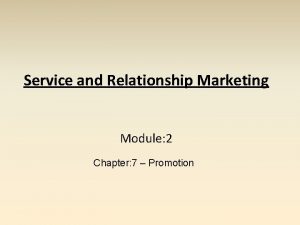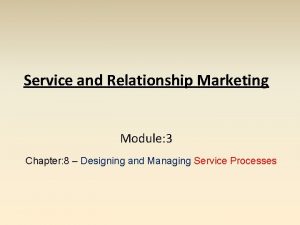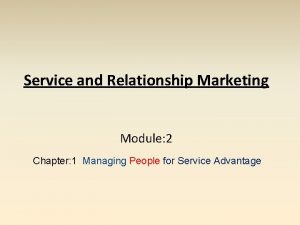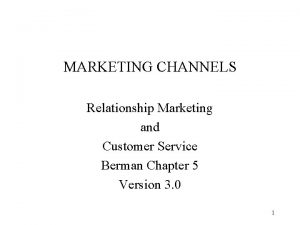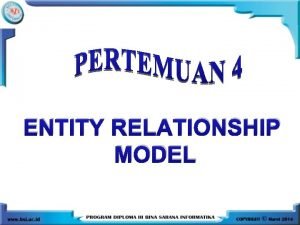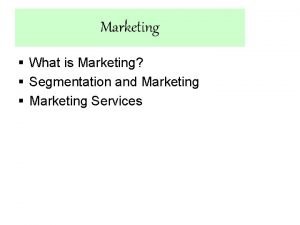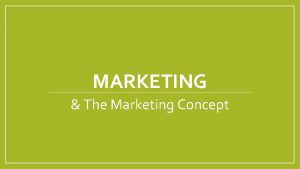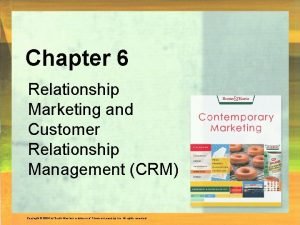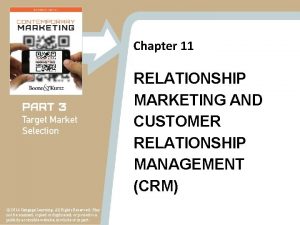Service and Relationship Marketing Module 4 Relationship Marketing



































- Slides: 35

Service and Relationship Marketing Module: 4 Relationship Marketing

The Search for Customer Loyalty

How Much Profit a Customer Generates Over Time

Why Customers Are More Profitable Over Time

Why is Customer Loyalty Important to a Firm’s Profitability? • Customers become more profitable the longer they remain with a firm: – Increased purchases and/or account balances • - Customers/families purchase in greater quantities as they grow – Reduced operating costs • - Fewer demands from suppliers and operating mistakes as customer becomes experienced – Referrals to other customers • - Positive word-of-mouth saves firm from investing money in sales and advertising – Price premiums • - Long-term customers willing to pay regular price • - Willing to pay higher price during peak periods

Assessing the Value of a Loyal Customer • Must not assume that loyal customers are always more profitable than those making one-time transactions – Costs • - Not all types of services incur heavy promotional expenditures to attract a new customer • - Walk-in traffic more important at times – Revenue • - Large customers may expect price discounts in return for loyalty • - Revenues don’t necessarily increase with time for all types of customers

Assessing the Value of a Loyal Customer • Must not assume that loyal customers are always more profitable than those making one-time transactions – Costs • - Not all types of services incur heavy promotional expenditures to attract a new customer • - Walk-in traffic more important at times – Revenue • - Large customers may expect price discounts in return for loyalty • - Revenues don’t necessarily increase with time for all types of customers

Assessing the Value of a Loyal Customer • Profit impact of a customer varies according to stage of service in product life cycle – e. g. , referrals and negative word-of-mouth have a higher impact in early stages • Tasks: – determine costs and revenues for customers from different market segments at different points in their customer lifecycles – predict future profitability

Understanding the Customer-Firm Relationship

Transactional Marketing • Transactional Marketing – One transaction or a series of transactions does not necessarily constitute a relationship – Requires mutual recognition and knowledge between the parties

Relationship Marketing • Marketing that creates extended relationships with customers • Database Marketing: – Includes market transaction and information exchange – Technology is used to (1)Identify and build database of current and potential customers (2)Deliver differentiated messages based on customers’ characteristics (3)Track each relationship to monitor cost of acquiring that customer and lifetime value of resulting purchases

Relationship Marketing • Interaction Marketing: – Face-to-face interaction between customers and supplier’s representatives – Value is added by people and social processes – Increasing use of technologies make maintaining relationships with customers a challenge • e. g. , self service technology, interactive website, call centers • Network Marketing: – Common in B 2 B context – Companies commit resources to develop positions in a network

Why are Customers Loyal? (Service Insights 12. 1) = Customers stay loyal when we create value for them = Value can be created for customers through: – Confidence benefits - Confidence in correct performance - Ability to trust the provider - Lower anxiety when purchasing - Knowing what to expect and receive – Social benefits - Mutual recognition and friendship – Special treatment - Better price - Discounts not available to most customers - Extra services - Higher priority when there is a wait

Understanding the Customer-Firm Relationship

Relationships with Customers Type of Relationship Between the Service Organization and its Customers Nature of Service Membership Delivery Relationship Continuous • Cable TV • Insurance Policy • College enrollment Discrete Transactions No Formal Relationship • Radio Station • Police • Lighthouse • Subscriber phone • Pay Phone • Theater subscription • Movie Theatre • Warranty repair • Public Transport

The Wheel of Loyalty

Strategies for Reducing Customer Defections

Analyze Customer Defections and Monitor Declining Accounts • Understand reasons for customer switching • Churn Diagnostics – Analysis of data warehouse information on churned and declining customers – Exit interviews: • - Ask a short set of questions when customer cancels account; in-depth interviews of former customers by third party agency – Churn Alert Systems: • - Monitor activity in individual customer accounts to predict impending customer switching • - Proactive detention efforts – send voucher, customer service representative calls customer

What Drives Customers to Switch?

Addressing Key Churn Drivers • Delivery quality • Minimize inconvenience and non-monetary costs • Fair and transparent pricing • Industry specific drivers – Cellular phone industry: handset replacement a common reason for subscribers discontinuing services – offer proactive handset replacement programs • Reactive measures – Save teams

Other Ways to Reduce Churn • Implement Effective Complaint Handling and Service Recovery Procedures • Increase Switching Costs – Natural switching costs • - e. g. , Changing primary bank account – many related services tied to account – Can be created by instituting contractual penalties for switching • - Must be careful not to be perceived as holding customers hostage • - High switching barriers and poor service quality likely to generate negative attitudes and word of mouth

CRM: Customer Relationship Management

Objectives of CRM Systems • Data collection – Customer data such as contact details, demographics, purchasing history, service preferences • Data analysis – Data captured is analyzed and categorized – Used to tier customer base and tailor service delivery accordingly • Sales force automation – Sales leads, cross-sell and up-sell opportunities effectively identified and processed – Track and facilitate entire sales cycle

Objectives of CRM Systems • Marketing automation – – Mining of customer data enables the firm to target its market Goal to achieve one-to-one marketing and cost savings Results in increasing the ROI on its marketing expenditure Enables the assessment of the effectiveness of marketing campaigns through the analysis of responses • Call center automation – Call center staff have customer information at their fingertips resulting in improved service levels to customers. – Caller ID and account numbers allow call centers to identify the customer tier the caller belongs to, and to tailor the service accordingly.

Integrated Framework for CRM Strategy Development Process Value Creation Process Multi-channel Performance Integration Assessment Process Information Management Process Source: Adapted from: Adrian Payne and Pennie Frow, “A Strategic Framework for Customer Relationship Management, ” Journal of Marketing 69 (October 2005): 167 -176.

CRM: Strategy Development • Strategy Development – Responsibility of top management – Used to guide the development for the customer strategy – Assessment of business strategy

CRM: Value Creation • Value Creation – Translates business and customer strategies into specific value propositions for both customers and firm • - Customers benefit from priority, tiered services, loyalty rewards, and customization • - Company benefits from reduced customer acquisition and retention costs, and increased share-of-wallet – Dual creation of value: customers need to participate in CRM to reap value from firm’s CRM initiatives

CRM: Multi-Channel Integration • Multi-Channel Integration – Serve customers well across many potential interfaces – Offer a unified interface that delivers customization and personalization

CRM: Performance Assessment • • Is CRM system creating value for key stakeholders? • Is CRM system meeting performance standards? Are marketing and service standard objectives being achieved?

CRM: Information Management • Information Management – – Collect customer information from all channels Integrate it with other relevant information Make useful information available to the frontline Create and manage data repository, IT systems, analytical tools, specific application packages

Integrated Framework for CRM Strategy

Common Failures in CRM Implementation • Service firms often equate installing CRM systems with having a customer relationship strategy • Common reasons for failures – – – Viewing CRM as a technology initiative Lack of customer focus Insufficient appreciation of customer lifetime value (CLV) Inadequate support from top management Failure to reengineer business processes Underestimating the challenges in date integration

Defining a CRM Strategy • How should our value proposition change to increase customer loyalty? • How much customization or one-to-one marketing and service delivery is appropriate and profitable? • What is incremental profit potential of increasing share-of-wallet with current customers? How much does this vary by customer tier and/or segment? • How much time and resources can we allocate to CRM right now? • If we believe in customer relationship management, why haven’t we taken more steps in that direction in the past? • What can we do today to develop customer relationships without spending on technology?

Summary • Customer loyalty is an important driver of profitability so firms need to assess lifetime customer value and narrow gap between actual and potential value • Building a foundation of loyalty involves – Good fit between customer needs and capabilities – Tiering services effectively – Obtaining customer satisfaction through service quality • Customer loyalty bonds include – Reward-based, social, customization, and structural bonds – Created through membership and loyalty programs

Summary • Strategies for reducing customer defections include – Analyzing customer defections and monitoring declining accounts – Addressing key churn drivers, increasing switching costs – Implementing effective complaint-handling and service recovery procedures • A successful CRM program requires understanding of common failures while including the following processes – – Strategy development process Value creation process Multichannel integration process Performance assessment process
 Principles of marketing grade 12 module 2 answer key
Principles of marketing grade 12 module 2 answer key Importance of relationship marketing
Importance of relationship marketing Customer relationship pyramid
Customer relationship pyramid C device module module 1
C device module module 1 New service development process cycle
New service development process cycle Customer service module
Customer service module Self perceived service role
Self perceived service role Soa architecture
Soa architecture Principles of marketing quarter 2 module 9
Principles of marketing quarter 2 module 9 Principles of marketing quarter 2 -- module 7
Principles of marketing quarter 2 -- module 7 6 marketing principles
6 marketing principles Business ethics and social responsibility module 5
Business ethics and social responsibility module 5 Principles of marketing module 10
Principles of marketing module 10 Principles of marketing module 8
Principles of marketing module 8 Marketing mix module
Marketing mix module Erp sales module
Erp sales module Exchange transaction and relationship in marketing
Exchange transaction and relationship in marketing Medical practice marketing and customer service
Medical practice marketing and customer service Lovelock chapter 9
Lovelock chapter 9 Nature of service marketing
Nature of service marketing Service supply relationship
Service supply relationship Two-level bidirectional service supply relationship
Two-level bidirectional service supply relationship Service supply relationship adalah
Service supply relationship adalah Order management & customer service relationship concept
Order management & customer service relationship concept Itil service lifecycle service transition
Itil service lifecycle service transition Itil five stages
Itil five stages 8 step improvement
8 step improvement Mpls class of service
Mpls class of service Service owner vs service manager
Service owner vs service manager Help desk improvement plan
Help desk improvement plan Adp self service login
Adp self service login Module 5 supply and demand introduction and demand
Module 5 supply and demand introduction and demand Finer segmentation
Finer segmentation Marketing information systems and marketing research
Marketing information systems and marketing research Define marketing information management
Define marketing information management Marketing information systems and marketing research
Marketing information systems and marketing research

